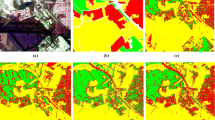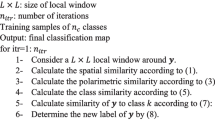Abstract
The potential of quad polarization radar data for the target discrimination has been analyzed. Quad polarization data of the RADARSAT-2 fine resolution mode has been utilized. Class separability analysis has been carried out on different polarization combinations using Transformed Divergence (TD) method and it is observed that HH-HV/VH-VV polarization combination gives better class separability when compared to other polarization combinations. Classification has been carried out on the optimized polarization combination using Maximum likelihood (MLC) and Support Vector Machine (SVM) classifiers. It is observed that SVM classification gives better classification accuracy compared to MLC. Overall classification accuracy is 93.03% for SVM and 88.78% for MLC. Class separability and classification accuracy comparison results are presented.



Similar content being viewed by others
References
Dell’acqua, F., & Gamba, P. (2003). Texture-based characterization of urban environments on satellite SAR images. IEEE Transactions on Geoscience and Remote Sensing, 41, 153–159.
Gualtieri JA and Cromp RF (1998) Support vector machines for hyperspectral remote sensing classification. Proc. of the 27th AIPR Workshop: Advances in computer assisted recognition, Washington DC, pp. 221–232
Hall, F. G., Townshend, J. R. G., & Engman, E. T. (1995). Status of remote sensing algorithms for estimation of land surface state parameters. Remote Sensing of Environment, 51, 138–156.
Hansen, M., Dubayah, R., & DeFries, R. (1996). Classification trees: An alternative to traditional land cover classifiers. International Journal of Remote Sensing, 17, 1075–1081.
Hegaratmascle, S., Vidalmadjar, D., Taconet, O., & Zribi, M. (1997). Application of shannon information theory to a comparison between L and C band SIR polarimetric data versus incident angle. Remote Sensing of Environment, 60, 121–130.
Henderson, F. M., & Xia, Z. G. (1998). Radar applications in urban analysis, settlement detection and population estimation. In: Manual of Remote Sensing (pp. 759–761). New York: Wiley Publishers.
Huang, C., Davis, L. S., & Townshend, J. R. G. (2002). An assessment of support vector machines for land cover classification. International Journal of Remote Sensing, 23(4), 725–749.
Jensen, J. R. (2004). Introductory digital image processing: A remote sensing perspective. New York: Prentice-Hall Inc.
Joachims T (1998) Text categorization with support vector machines—learning with many relevant features. Proc. of European conference on machine learning, Chemnitz, Berlin, Germany, pp. 137–142
Latty RS and Hoffer RM (1980) Waveband evaluation of proposed Thematic Mapper in forest cover classification. Proc. of the Fall Technical Meeting, ACSM-ASP, Niagara Falls, New York, pp 1–12
Lillesand, T. M., & Kiefer, R. W. (2000). Remote sensing and image interpretation. New York: John Wiley and Sons Publishers.
Lothar H, Dieter F, Puzicha J and Buhmann JM (1999) Support vector machines for land usage classification in LANDSAT TM imagery. Proc. of IGARSS Volume I, pp. 348–350
Swain, P. H., & Davis, S. M. (1978). Remote Sensing: The Quantitative Approach. New York: McGraw-Hill Publishers.
Townshend, J. R. G. (1992). Land cover. International Journal of Remote Sensing, 13, 1319–1328.
Toyra, J., Pietroniro, A., & Martz, L. (2001). Multisensor hydrologic assessment of a freshwater wetland. Remote Sensing of Environment, 75, 162–173.
Vapnik, V. N. (1995). The Nature of Statistical Learning Theory. New York: Springer-Verlag Publishers.
Wang, F. (1990). Fuzzy supervised classification of remote sensing images. IEEE Transactions on Geoscience and Remote Sensing, 28, 194–201.
Weydahl, D. J. (2002). Backscatter changes of urban features using multiple incidence angle RADARSAT images. Canadian Journal of Remote Sensing, 28, 782–793.
Author information
Authors and Affiliations
Corresponding author
About this article
Cite this article
Joseph, M., Subramoniam, S.R., Srinivasan, K.S. et al. Class Separability Analysis and Classifier Comparison using Quad-polarization Radar Imagery. J Indian Soc Remote Sens 41, 177–182 (2013). https://doi.org/10.1007/s12524-011-0177-0
Received:
Accepted:
Published:
Issue Date:
DOI: https://doi.org/10.1007/s12524-011-0177-0




